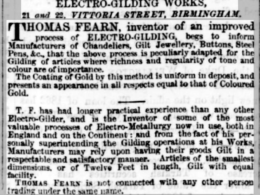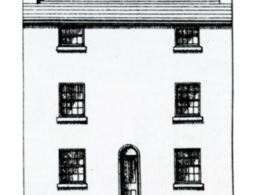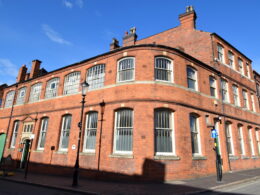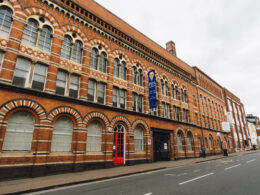By Steve Rose, research volunteer, and Sophie Slade
Formed of six back-to-back houses known as Hill’s Buildings, they were set around a courtyard. Shopping (workshops) was added behind No.24 after the 1880s. Residents at Nos 22-24 first appear in the census records in 1861. Like much of the Jewellery Quarter the residential properties were gradually re-purposed for industrial use or through a type of hybrid live-work model adopted by residents.
Birmingham houses and how they were laid out
The layout of these houses had two at the front, one on each side of the central doorway, which led to the rear courtyard; two houses built on the back of the front two; and two houses at the back of the courtyard. The back houses were accessed from the central passage. Each of the two front houses was accessed from their own entrance, to the left of No.22 and the right of No.24. You can still see where these were bricked up at some point.
Each house had a ground floor room which served as a living, kitchen, dining and bathing room. There was a bedroom on the first floor and a high attic room. All the houses shared a few toilets and ‘brewhouses’, in the courtyard. Also known as a brewus, this was not for brewing but actually a place for washing clothes.
Industry and Innovation at Nos 22-24
A snapshot of the residents at Hill’s Buildings shows how people living in the Quarter began to work in jewellery trades, both off and on site. As these trades grew, some established their own businesses, and the courtyards behind the houses were filled up with shopping (workshops). In 1845, long before the shopping was added, Tipson Brothers made livery buttons at No.22.
In the 1860s, Thomas Fearn, also based at No.22, invented an improved process of electro-gilding for silverware. His newspaper adverts were numerous and show a flair for marketing.
By 1891, the houses were full of families and individuals working locally or from home. For example, a 73-year-old widow lived and worked as a jewellery case maker at No.22; while a 21-year-old electro-plate polisher lived in one of the back houses, with his wife and baby. By 1901 the occupiers were mostly jewellery trade businesses.
The building was conserved with a JQTH grant in 2021.






